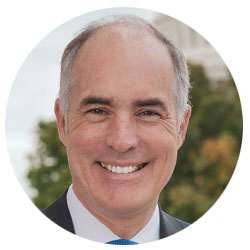
NASEM Report Calls for Sweeping Reorganization of Nursing Home Industry
Two LDI Senior Fellows Weigh in on Decades of Industry Shortcomings
Improving Care for Older Adults
News | Video
For decades, the country’s long-term care system has been notorious for its poor care, poor staffing levels, poor patient conditions, and poor regulatory oversight. The latest effort to devise a plan to address these deficiencies came in the April 2022 release of the National Academies of Sciences, Engineering, and Medicine’s (NASEM) consensus study, “The National Imperative to Improve Nursing Home Quality.” Three members of the committee that created that report, along with U.S. Senator Bob Casey from Pennsylvania and a veteran Capitol Hill political consultant, came together to discuss these issues in a May virtual seminar organized by the University of Pennsylvania’s Leonard Davis Institute of Health Economics.

Setting the scene was seminar host David Grande, MD, MPA, Penn LDI Director of Policy: “The long-term care system is one of the greatest challenges in health care today and a challenge that became acutely visible during the pandemic,” he said. “It is the largest gap in our patchwork American health care system involving more than 1.4 million individuals in over 15,500 nursing homes. Thirty years after the 1986 Institute of Medicine report identifying inadequate care and abuse in these facilities, we’re still failing to protect nursing home residents or provide them with high quality care.”
In November 2020, near the close of the pandemic’s first year and as the nation’s nursing homes were experiencing apocalyptic levels of coronavirus mortality, NASEM assembled its special twelve-member committee of top experts to examine the overall operational conditions and infection control failures across that long-term care system.
Participating in the Penn LDI seminar, three of those committee members — Mary Ersek, PhD, RN; Jasmine Travers, PhD, RN; and Rachel M. Werner, MD, PhD — discussed some of the top priorities that resulted from the 18-month-long NASEM consensus study project.

Ersek, a Professor in both the Penn School of Nursing and the Perelman School of Medicine, and a leading national authority on nursing home care and end-of-life care, cited the inadequate quality measurement methods currently used for evaluating whether or not good care has been delivered in long-term care settings.
“The committee talked a lot about quality measurement,” Ersek said. “In nursing homes, we measure many quality indicators, yet there was a glaring omission in all those outcomes and process measures — the resident and family voice. In most health care settings such as hospitals, hospices, and home care there have been developed and publicly reported patient experience measures. But despite the fact that these measures of patient experience or resident experience have been developed for nursing homes, those have not been deployed on a national basis. The committee consensus was that we really need to have a patient experience measure.”
Travers, an Assistant Professor at New York University’s Rory Meyers College of Nursing pointed out that “the COVID pandemic has been a workforce 911 moment for nursing homes — staffing shortages have been reported long before the rise of coronavirus but these shortages continued to increase throughout the pandemic. In May of 2020, 21 percent of nursing homes reported staff shortages. Now, in May of 2022, that number has increased to 28 percent of nursing homes.”

“There are a number of factors driving this,” Travers continued. “That includes high work demands, lack of adequate training, low pay, poor benefits and high turnover among clinical staffers, nursing assistants, and administrators. Research shows that high turnover among administrators and top-level executives is associated with an even higher turnover rate among the clinical staff. Overall, the employee pool is just not there. We have greater demand for nursing home staff than we have supply. We need to work on that. Nursing homes pay less than acute care and ambulatory care settings which also provide employees with better benefits and less demanding conditions.”
“Beyond that,” said Travers, “the federal minimum staffing standards are not high enough at the same time they are not enforced in the ways they need to be enforced.”
Werner, Executive Director of Penn LDI, a Professor at both The Wharton School and the Perelman School of Medicine, and a leading national expert in the field of nursing home quality, payment and financing, said her top priority for nursing home reform is its system of payment.
“It’s hard to imagine reforming nursing homes without reforming how we pay for and prioritize the payment of long-term care for nursing home residents,” Werner explained. “Nursing homes generally include two distinct populations of residents: long stay residents, which make up about two thirds of the nursing home residents whose stays are predominantly paid by Medicaid, and short-stay residents, sometimes referred to as residents in post-acute care, paid predominantly by Medicare.
“Medicaid rates are quite low and although people who are enrolled in Medicaid make up about two thirds of the nursing home population, the percentage of the revenue generated by Medicaid is less than half of nursing home revenue,” Werner continued. “So, not surprisingly, the average margin for nursing homes in these areas is negative — about minus two percent.”

“On the other hand, Medicare rates for post-acute care are really quite high compared to Medicaid rates, resulting in margins that are above 10 percent,” Werner said. “It’s a source of revenue that nursing homes have come to rely on but it creates a lot of problems in the financing of nursing homes. For instance, it causes fragmentation of care, where there’s little incentive to coordinate care across payers and across providers. For nursing home residents, it creates something that we refer to as cross subsidization or using the Medicare revenue to cover Medicaid shortfalls. That results in overuse of Medicare services and the selection of patients who qualify for Medicare services over people who might be enrolled in Medicaid. It also results in inequitable care.”
“We know nursing homes located in historically marginalized communities often have lower staffing levels and lower quality of care. So, this is not a system that any of us would have put together had we set out to create a rational system of providing long term care. That’s why one of the very important points made in the NASEM report is that we can’t achieve meaningful nursing home reform without the establishment of a federal long term care benefit. That means a single federal agency to pay for nursing home care, not just for people who currently qualify for care through Medicaid or Medicare, but for all people who need long term care, and many of whom are currently shut out of the long-term care system.”
The obvious need for a more coherent and inclusive national long-term care system has been widely recognized in recent decades, particularly as the wave of Baby Boomers age into infirmity at a rate requiring far more well-staffed, high-quality long-term care facilities than now exist. But each national legislative effort that has attempted to achieve this goal of expanded and reformed long-term care has failed. The last such case was the collapse of the Community Living Assistance Services and Supports Act (or CLASS Act) that was originally included in the Affordable Care Act in 2010 but, lacking a viable financing framework, was excised from the ACA at the eleventh hour.
One of the policymakers most intensely involved in this effort to re-envision long-term care at the state and federal levels over the last 30 years is U.S. Senator Bob Casey, a participant in this Penn LDI virtual seminar.

Casey, a Democrat who has served in the U.S. Senate for 16 years, is a member of the Senate Finance Committee and the Senate Health Committee. He is also Chairman of the Special Committee on Aging. His comprehensive understanding of the long-term care issue is rooted in his two-term 1990’s tenure as Pennsylvania Auditor General leading on-site performance audits of the state’s nursing homes. He remembers being “horrified” by the findings, one of which was that “emergency priority one” complaints “were not being investigated at all, or in a timely fashion.”
Casey said his sense of outrage from those experiences is part of what drives his current intense legislative focus on the nursing home issue and the divisive Capitol Hill politics that have long thwarted logical, evidence-based solutions for its problems.
“We arrived at the point last year in the Build Back Better plan where we had 50 votes in the Senate to dedicate $150 billion in new money to home and community based long-term care but those votes were all Democrats (the legislation was defeated by one vote). We can’t get Republicans to embrace the kind of investment we need, not just to improve the existing options for families in long-term care setting generally, but for home and community-based services. It’s not just that Republican circles in the House and Senate don’t want to add money. In budget after budget, they have proposed cuts to Medicaid.” Medicaid is the largest single payer for long-term care services across the U.S.
Another of Casey’s initiatives focuses on the Centers for Medicare and Medicaid Services’ “Special Focus Facility” program — that, by law, calls for special inspections of nursing homes identified as problematic facilities. In May he publicly reported that one in five such facilities are currently overdue for inspections and called on CMS to take action.
“The Special Focus program is not covering enough of the problems or enough of the facilities that have a record of demonstrated poor performance,” Casey said. “The goals of the program are worthy but they’re just not covering the hundreds and hundreds of facilities that could be the subject of special focus.”
In related efforts, Casey worked with Pennsylvania’s other U.S. Senator, Republican Patrick Toomey and with Senator Ron Wyden (D-Oregon), chairman of the Finance Committee, on the Nursing Home Improvement and Accountability Act, that would set minimum nursing home staffing standards, raise staffing wages, require round-the-clock registered nurse presence, implement comprehensive infection control and prevention measures, and implement financial transparency and accountability measures.
Casey said: “We hope to get at least portions of that enacted into law.”

Panelist Rodney Whitlock, PhD, is an executive at McDermott+Consulting, a Washington D.C. consulting and lobbying firm, and a long-time veteran of Capitol Hill’s legislative establishment. From 2005 to 2015 he served as both Health Policy Director for Senator Charles (Chuck) Grassley (R-Iowa) and as lead Republican staffer for Medicaid legislation.
Whitlock credited Sen. Casey with changing the Congressional status of long-term care reform from that of a “minor footnote” to a major issue over the last two years. He noted that much of Republican resistance to comprehensive reform and the funding it would require is rooted in a concern about the national debt service that is rising toward 12 percent when the U.S. economy itself is growing only by about four percent.
He suggested that Republicans already have a model for reform, the Medicare Part D program launched in 2006 that provides drug benefits covered by private insurance plans funded by enrollee cost-sharing, government subsidies, and pharmaceutical industry rebates.
“We have to be thoughtful about how we go about it,” Whitlock said. “It’s working toward solutions that try to combine public resources, private resources and the resources of the individual to create the mechanism that gets you to a more systemic approach than we have now.”
“The first thing we need to do is come up with a common understanding of what high quality long-term care is,” Whitlock continued. “This is controversial. We already have standards in acute care, but we don’t have enough of a set of minimum standards of what our expectations are in long-term settings. And we don’t pay enough to be able to make sure we meet those. For many long-term care providers, the standard is getting through the day without something going horribly wrong. That’s not acceptable. You wouldn’t expect that at your pediatrician or hospital or dermatologist. But we do that every day in long-term services and support facilities.”
“Are we likely to see more bipartisan support emerge for reform in areas of long-term care any time soon?,” Whitlock was asked.
“Republicans aren’t anti-caring for people,” said Whitlock. “They’re worrying about that 12 percent number I threw at you. What we have to do is get people to the point where they’re willing to sit down and try to be creative in a place where it’s not really easy to sit down and try to be creative. That’s the challenge. But I keep hope alive. That’s why I’m still here.”


Two LDI Senior Fellows Weigh in on Decades of Industry Shortcomings
Informal Caregiving Continues in Nursing Homes, Assisted Living

Study Finds Pre-Existing Burnout and Dissatisfaction Poses a Persistent Risk to Public Health

A Workforce in Crisis
Can It Reduce Nursing Turnover?
Learning from international and state models